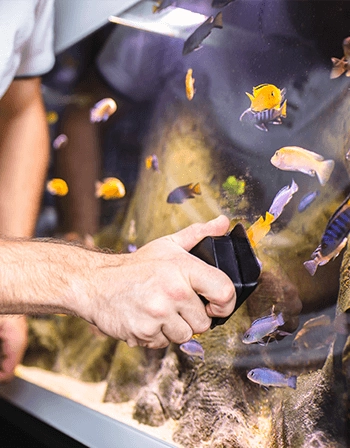
How to Be a Better Owner for a Pet Rabbit

Improve pet rabbit welfare in the home and vet clinic with simple techniques.
Updated July 7, 2023 | Source: Dr. Lori Gaskins for Psychology Today; Reviewed by Gary Drevitch

Source: Photo by Satyabratasm on Unsplash
by Lori Gaskins, DVM, DACVB, DACAW
Research regarding rabbit welfare and behavior indicates that there are many things that general practitioners and pet rabbit owners can do to improve the welfare of pet rabbits.
Veterinarians can play an active role in improving rabbit welfare during veterinary visits by using and recommending stress-reducing techniques. Some of these techniques include recommending owners bring a bonded companion to the exam; using aromatherapy; handling in a stress-free fashion; and offering treats and hiding places.
Veterinarians can also help prevent behavioral complaints of owners such as aggression, destruction, and house soiling. The majority of rabbits are fearful when lifted and handled, which can result in aggression to owners. Providing advice on reading the communication signals of rabbits and not handling them in ways that induce fear will decrease the risk of injuries to both the pet and the owner, and improve the human-animal bond. Other examples of responsible advice include housing the rabbit in a large and complex environment, getting rid of the food bowl and allowing the rabbit to forage for food, providing water in a bowl and not a water bottle, providing an appropriate litterbox, and always providing a companion and a hiding place. If veterinarians educate owners regarding their rabbits’ innate behaviors and emotions, this will increase the likelihood that each owner will provide a more welfare-friendly home for their pet.
How Rabbit Owners Can Improve Their Pets’ Welfare
Pet rabbit owners can improve their pet’s welfare in the home by providing their rabbit with companionship, foraging opportunities, hiding places, perches, digging boxes, positive reinforcement training, proper litterboxes, and a large enough enclosure to provide all of these things. Additionally, since the majority of rabbits are fearful when lifted and handled, these practices should be discontinued. An alternate method of moving the rabbit around is to train the rabbit to target an object, such as a finger or a stick with a ball on the end. The pet should be trained with positive reinforcement to place his nose on the target. This is done by luring the rabbit to the target with his favorite treat, then giving the treat if he sniffs or touches the target. Once the rabbit is trained to move to wherever the target is in order to touch it, the target can be placed wherever the owner wants the rabbit to go. This allows for fun interactions that can replace those that include picking the rabbit up and cuddling him.
Pet rabbit owners should work to decrease the stress of traveling, whether it’s for boarding or veterinary visits. The target training will help here, as the owner can place the target in a crate to get the rabbit crated for travel. Travel stress can also be decreased by always allowing bonded rabbits to travel together, using non-slip flooring in the crate, covering the crate with a towel, using aromatherapy such as lavender or valerian or blended essential oils, and providing favorite treats in the crate.
The 5 Domains of Welfare and the Pet Rabbit
Improving rabbit welfare can be accomplished using the framework of the 5 Domains of Welfare.
- Health: Provide timely veterinary visits to ensure the rabbit is physically and mentally healthy.
- Nutrition: Provide a nutritionally balanced diet and require rabbits to forage for food as nature intended.
- Environment: Provide natural light, appropriate temperatures, and hiding places.
- Behavioral Interactions: Provide a rabbit companion, stress-free interactions with humans, and a complex mentally stimulating environment which simulates the natural environment.
- Mental state: Provide a life that approximates what nature intended and therefore makes life worth living.

Dr. Lori Gaskins – Lori Gaskins is a veterinarian who is a diplomate of the American College of Animal Welfare and of the American College of Veterinary Behaviorists. She has been a practicing veterinarian for over 30 years and has been teaching animal welfare and behavior for 16 years. For more, see her ACVB Webinar on Rabbit Behavior and Welfare.
Introducing Petfundr!
PetFundr provides crowdfunding for your pet’s urgent, acute or chronic care needs. With PetFundr, you can do it fast, reliably and for FREE!

Mila Gets Needed Bladder Surgery With Help from Angel Fund Grant

For more information about the Animal Health Foundation’s Angel Fund CLICK HERE
Yelena and her mother have been rescuing dogs and cats they find on the streets near their Reseda home for years, often finding them homes, if they cannot locate their owners.
That’s how they found Mila nearly two years ago. A Poddle mix, she “was running around and she was in horrible condition,” said Yelena, who asked that Pulse not use her full name. “She clearly had not been eating well and she was covered with fleas. I had to give her three baths, one after the other.
“We tried to find her owner. She did not have a chip. We posted a description of her and some people contacted us and said they thought she was their dog. But none of them sent us a picture of her and we ended up keeping her. I think we gave her a really good life.”
A few months ago, Yelena noticed that Mila “was straining to pee. I checked her and there was no blood. But I took her to the vet, who asked if I had seen any blood and if Mila was eating. The vet prescribed antibiotics, thinking the problem might be an infection.
“That seemed to help her a little bit. But then I took her to the dog park and every five seconds she was squatting down and acting like she was going to pee. And I decided I would take her either to the emergency clinic or the vet. Then I looked again and I finally saw some blood.”
Yelena called VCA McClave Animal Hospital not far from her home. “I told them exactly what was going on. They said this was an emergency, since there was blood, and to bring her in. Dr. Carina Cortez told me that they would prefer to do x-rays and a few other procedures,” Yelena said.
“I was thinking, oh this poor dog! When Dr. [Nada] Khalaf [co-medical director at McClave] called me after she saw the dog, she told me: ‘We can’t keep giving her antibiotics – we would just be going in circles.’”
Dr. Khalaf said that she saw the stone shadow on an ultrasound. She told Yelena that she suspected stones but needed radiographs to confirm they were there. When the x-rays were taken, they showed “two enormous stones in her tiny bladder,” Yelena said.
“I said that I wanted to help the dog, but I really couldn’t financially, and I asked if there was any kind of financial plan I could do. And Dr. Khalaf said she could refer me to Angel Fund. I had never heard of Angel Fund. She said: ‘I don’t know how much they can help you’ but that she would call and we would see.
“And I was thinking, ‘Oh my god, maybe they would help!’ Dr. Khalaf called back and said Angel Fund would help. I was thinking maybe $100 or $300. But the doctor said they would do more – $1,000 – and the hospital also would help, matching the grant, and that they would help me open a CareCredit account.
Dr. Cortez performed the surgery to remove the stones.
“I was really so grateful,” Yelena said. “I am just very, very thankful.” She also expressed gratitude to Dr. Khalaf: “She’s the one who helped set everything up.”
She also said that she would “rate Angel Fund at 200 on a scale of 100.” The day she learned that she was getting the grant “was a very emotional day for me.”
Mila is now doing well, she said. “After the surgery we had some antibiotics and pain medication. She was told to keep Mila from running and jumping for two weeks but the dog wanted to do just that. She now urinates normally. “She’s 100 percent different from the way she was in the dog park.
“Mila is a very special dog.”
Jonathan the Tortoise, The World’s Oldest Animal, Turns 190
DEC 8, 2022 from Twisted Sifter https://twistedsifter.com/2022/12/jonathan-the-tortoise-the-worlds-oldest-animal-turns-190/?utm_source=040523-FP-WIMP-FB&utm_medium=WIMP-FB&utm_campaign=WIMP-FB&utm_content=2022%2F12%2Fjonathan-the-tortoise-the-worlds-oldest-animal-turns-190
Happy 190th birthday to the oldest animal, and oldest tortoise, in the human record.
His name is Jonathan and he was given the title by the Guinness World Records, after confirming that he hatched in 1832 based on photographic records.

According to The Guardian, governor of the British overseas territory Nigel Phillips declared Jonathan’s birthday to be December 4, 1832. The tortoise was then feted like royalty, including a three-day celebration at the governor’s residence on the island of St Helena in the South Atlantic and a reptile-friendly cake.
The only official record used to prove Jonathan’s age was an old photograph that shows the turtle arrived on the island in 1882. In the photo, he appears to be fully mature and estimated to be at least 50 years old at that time, making his birth around 1832.

Impressive as his new title is, the birthday boy isn’t as spry as he once was. Jonathan is blind and has lost his sense of smell, but he still has a healthy appetite. Apparently, his favorite foods are lettuce hearts and bananas. Here’s to Jonathan and 190 more!
March is Pet Poison Prevention Month
What to Do If Your Dog Eats Marijuana (Edibles, Weed, Vape Cartridges, etc.)
The amount and type of THC-containing product consumed will determine the seriousness of this event for your dog, and dictate the level of your emergency response.
By Jennifer Bailey, DVM for WHOLE DOG JOURNAL Published: January 15, 2023
Recreational marijuana has become legalized in 21 states and medical marijuana can be prescribed in 37 states. As marijuana becomes more widely available, people are looking for ways to partake of this drug without having to smoke it. This has created a market for marijuana “edibles,” also known as cannabis edibles.
Cannabis edibles are products that contain the psychoactive component of marijuana called delta-9 tetrahydrocannabinol (THC). A variety of products are available as cannabis edibles, including gummies and other candies, mints, chocolates and chocolate bars, beverages, potato chips, and baked goods such as brownies and cookies. Unfortunately, many of these sweet or savory options are also attractive to our dogs. While we may have more self-control regarding how many edibles we consume at one time, dogs are more likely to ingest an entire package of any edibles they can reach because they taste delicious.
Symptoms of THC Ingestion in Dogs
Ingestion of small to moderate amounts of THC may cause the following signs in dogs: listlessness, incoordination when walking, falling over when standing, dilated pupils, slow heart rate, dribbling urine, and an exaggerated response to light, touch, and sound. Dogs who have ingested large amounts of THC may have slow breathing, low blood pressure, and may exhibit seizures or become comatose.
What to Do If Your Dog Ate a Cannabis Product
If you observe your dog ingesting cannabis edibles, take him to your veterinarian or the closest animal emergency or urgent care facility immediately. If the ingestion occurred within 30 minutes of arrival at the hospital and your dog is not showing clinical signs of THC ingestion, then the veterinary staff may induce vomiting.
If it has been more than 30 minutes since ingestion of the edible or your dog is showing signs of listlessness, then vomiting will likely not be induced. This is because THC has an anti-emetic effect; it can suppress vomiting. If your dog is already listless, causing your dog to vomit in this depressed state can lead to aspiration pneumonia. Activated charcoal may be administered to absorb THC and minimize the effect it has on your dog’s body. If the edible contains chocolate or xylitol, then additional treatments may be necessary.
What If You Are Not Sure If Your Dog Ate a Cannabis Product?
If your dog is exhibiting signs of THC ingestion, but you did not witness or find evidence of this, have your dog evaluated by a veterinarian immediately. Be honest about what you have in the home, including any products containing THC, prescription sedatives, vape cartridges (including nicotine), and illicit drugs. Children, seniors, and roommates living in the home may not always be forthcoming about what they are storing in their bedrooms, so be firm yet gentle when inquiring about the presence of these products. The veterinary staff wants only to help your dog. They are not interested in contacting authorities about anything illegal in your home.
The clinical signs of THC ingestion look similar to the signs associated with ingestion of other sedatives, nicotine, and antifreeze. There is an antidote for antifreeze ingestion and without this intervention, this toxicity is always fatal. Your veterinarian may want to complete additional testing to rule out other causes for your dog’s clinical signs so that the appropriate treatment plan is initiated.
Although there is a urine test for THC available for use in people, this test is not always accurate in dogs. Dogs metabolize THC differently than people, so there is a high rate of false negatives with this test. However, a positive test for THC is almost always compatible with THC ingestion.
If ingestion of THC is suspected and the potential source has been identified, the veterinary team may contact animal poison control for further guidance regarding treatment. There are a number of variables that can alter how THC affects your dog. These variables include how much was ingested, your dog’s weight and concurrent medical conditions, any medications or supplements your dog may be taking, how the THC was infused into the product, and if the edible contains chocolate or xylitol.
Brownies, chocolates, and chocolate bars containing THC add another dimension to your dog’s toxicity: ingestion of theobromine and caffeine. Both of these are contained in chocolate and are toxic to your dog. Just like with THC, the type of chocolate (such as dark or milk chocolate), the amount ingested and the weight of your dog dictate the danger level and recommended treatment. (See “What to Do If Your Dog Eats Chocolate.”)
Gummies, mints, other THC edible candies and even baked goods may contain xylitol, an artificial sweetener that is toxic to dogs. Even tiny doses of xylitol are toxic to dogs, so it is important to know if any edibles your dog may have consumed contain xylitol.
Treatment for Cannabis Ingestion
Most mild cases of THC ingestion can be treated successfully at home by keeping your dog in a safe, quiet room where he cannot fall down the stairs or be exposed to excessive light or sound. Moderate cases of THC ingestion may require hospitalization with intravenous fluids, monitoring of heart rate and blood pressure, and medications to support the cardiovascular system and treat neurologic signs. Ingestion of high doses of THC will require hospitalization and may necessitate the administration of intralipids. Intralipids bind to THC so that it can be excreted safely from the body.
Ingested THC is fat soluble and is readily stored in body fat. Therefore, it can take anywhere from 12 to 36 hours for your dog’s clinical signs to resolve after ingesting a cannabis edible.
If you use cannabis products, store them in a locked drawer or cabinet. Dogs are clever and some can open drawers and cabinets, but I have yet to meet one that can insert a key in a lock!
Dr. Jennifer Bailey is a 2012 graduate of the Western University of Health Sciences College of Veterinary Medicine. She is an emergency and urgent care veterinarian at an emergency and specialty practice in Syracuse, New York.
Love Aquariums?


We found a place that gives you all of the information you need about taking care of fish and aquariums.
Want to know how to care for any type of aquarium fish? Go to their FISH KEEPING GUIDE section.
Want reviews on the Best Aquarium Supplies? CLICK HERE
Simply Aquarium describes themselves:
Simply Aquarium is run by a group of dedicated aquarists who believe passionately that anyone can set up and maintain a successful aquarium. We strive to cut through the technicalities and keep things simple.
Our experienced writers have put together some of the most comprehensive yet straightforward aquarium and fish-keeping guides on the web. All to help make the best choices for you.
Expert guide to creating a pet budget

Pet ownership is a long-term investment with many different costs. Learn how to get a clear picture of how much pets cost from day one.
Written by Shannon Perry for Betterpet.com
— Medically reviewed by Dr. Dwight Alleyne
Updated May 23, 2022

Table of Contents
- Budget for initial pet costs
- Plan for recurring pet costs
- Other pet costs
- Budget for emergencies
- Tips for budgeting
- Budget for pets before adopting
- Frequently asked questions
The essentials
- Expect upfront expenses — These include everything from adoption/breeder fees to health care, essential supplies, and more.
- Develop a budget to ease stress — A clear expectation of how much your furry or fishy family member costs will help with financial planning.
- Spend now to save later — Invest in preventative care to reduce the long-term costs associated with pet ownership.
A new puppy or kitten, or finally investing in that saltwater tank you’ve dreamt of for years, is exciting. But without proper planning, the newest addition to your family can turn into a source of financial stress. Fortunately, it doesn’t have to be that way! Create a pet budget to avoid unpleasant surprises for you and the newest addition to your family.
Budget for initial pet costs
For some prospective owners, the upfront, one-time cost of getting a pet can be prohibitively expensive — particularly with puppies and kittens. It’s a good idea to have a clear understanding of the initial expenses that come with a pet, regardless of whether you’re adopting or buying.
| Dog | Cat | Fish | |
|---|---|---|---|
| Pet store or breeder fees | $500-$2,500+ | $400-$5,000+ | $1-$50+ |
| Spay/neuter exam & operation | $65-$300+ | $35-$300+ | n/a |
| Veterinary care | $600 avg | $600 avg | n/a |
| Pet supplies (bowls, tanks, toys, etc.) | $130 avg | $120 avg | $25-$500+ |
| Apartment pet deposit (for renters) | varies | varies | varies |
| Total upfront cost | $1,295-$3,530 | $1,155-$6,020 | $26-$550 |
Overall, adopting from a rescue or shelter is typically less expensive than buying a pet from a breeder. Some medical care, such as spay and neuter operations, are already included in the fee. Some rescues have specials where adoption fees are waived for certain types of pets. Other rescue shelters pay for all medical expenses or they may include medications.
Besides the initial purchase or adoption fees, renters can expect a bump in housing fees. In some cases, this may be a refundable deposit, but most property management companies require some kind of deposit. Even fish may require a pet deposit or face restrictions on tank size. Before you invest in an aquarium, consult with your rental company to find out if you can have fish and how much they may cost.
Plan for recurring pet costs
Pet food is the most common expense new pet owners anticipate, but other items need to be part of a pet budget. Like people, pets have recurring needs and costs for which you should be prepared.
- Pet food. Cat and dog owners should expect to pay between $10 and $50 every month. This depends on the pet’s size, age, breed, and other health factors. For fish, owners should expect to pay between $5 and $15 a month for most aquarium setups.
- Medications. Many prescription medications are typically sold in three-, six- and 12-month supplies. While the price varies depending on the medication, pet owners should budget about $30 a month for routine prevention. In some cases, bundles may be available that make purchasing more convenient or less expensive. Consult with your veterinarian for the price of specific medications related to treatments.
- Waste disposal. For these expenses, cat owners should expect to pay $14 to $30 a month, while dog owners who need puppy pads should budget around $20. In both cases, miscellaneous items like waste bags may add an extra $10 to the budget.
- Miscellaneous. It’s important to be realistic and budget for other monthly expenses as well. Pet owners who want subscription boxes should expect to add about $30 a month to their pet budget. Also, training can cost around $50 per hour, while obedience schools and “doggie boot camp” programs range from $200 to over $1,000 per week.
With fish, monthly maintenance costs depend on the setup. Owners typically don’t need to budget more than $10 a month as purchases are on an as-needed basis. In case of parasites in the tank, extra treatments may be necessary.
Estimated monthly costs
| Dog | Cat | Fish | |
|---|---|---|---|
| Food | $10-$50 | $10-$50 | $5-$15 |
| Medications | ~$30 | ~$30 | n/a |
| Waste disposal | ~$30 | $25-$40 | $10 |
| Housing fees | $10-$100 | ~$10 | varies |
| Miscellaneous costs | $30-$200 | $30-$200 | varies |
| Monthly total: | $80-$280 | $75-$130 | $15-$25 |
| Pet insurance | varies | varies | varies |
| Annual costs (est) | $1,200-$1,560 | $1,140-$1,800 | $60-$180 |
Keep in mind that rental and homeowners association fees vary — this list is intended as a guideline. Consult with your landlord or HOA, if applicable, about any yearly or monthly pet fees.
Other pet costs
Aside from monthly expenses and one-time pet costs, other things often come up with pet ownership. Vaccines, checkups, treatments, and other expenses are often left out of a budget. This leads to unpleasant surprises when it comes time for veterinary care or a big purchase. These types of expenses may be infrequent, but shouldn’t be forgotten when creating a pet budget.
| Frequency | Cost | |
|---|---|---|
| Preventative medications | Every six months | $130-$190 |
| Core vaccinations | Every three years | $90-$360 |
| Other vaccinations | Annually or every three years | $90-$360 |
| Routine check-ups | Annually | $45-$300 |
| Boarding* | Annually | $125-$250 |
*The average range for boarding fees is based on a five-night stay one time a year for a healthy pet. Those with special medical needs will likely experience a higher rate.
Most preventative medications range from monthly to annual purchases. It’s also important to note that not all vaccinations are required. Most aren’t, but core vaccinations are highly recommended. The rabies vaccination is a core vaccination and is required by law in many areas.
Budget for the unexpected
In some cases, costs may come up that don’t fit neatly into the pet budget. These might be specific to the situation. For example, if you travel with your dog, you may need to pay a hotel fee. Other miscellaneous expenses include pet furniture, food delivery, grooming, or aquarium décor.
Lastly, consider adding your pets to your will so that they’ll be taken care of if they outlive you. Name a willing caregiver and then update your legal documents to reflect that change. Don’t forget to include any monetary considerations for your pet’s ongoing care.
Budget for pet emergencies
It’s inevitable with pet ownership that you’ll be visiting the vet at some point for an emergency. For cat owners, this may come in the form of something like a urinary tract infection. UTIs can quickly become an emergency that requires immediate attention. For pets that venture outdoors, poison and unfortunate encounters with wildlife can also result in an emergency vet visit.
The average emergency vet visit starts at about $100 and can quickly jump to a few thousand or more. It’s wise to save between $1,000 to $2,000 for an emergency visit.
Tips for pet budgeting
There are a few things you can do to make budgeting for a dog or cat a painless experience, and improve your life as a pet parent.
Figure out monthly expenses — Create a list of purchases you expect every month. Consider dividing it into categories like necessities and bonus purchases. Choose brands your vet likes or that you feel good about, and explore different options, like types of dog food.
Set aside money every month — With infrequent and unplanned purchases, it’s important to determine how much you can afford to save with each paycheck. Some pet owners prefer to set aside a large amount at once, while others budget to set aside a little at a time.
Consider pet insurance — Emergency vet expenses can cost thousands, so many pet parents choose to invest in pet insurance. This offsets future costs and helps you save on routine care, medications, and vaccinations.
Interview pet sitters and boarders — A great way to plan for pet care is to establish a relationship with a boarding facility or pet sitter. Not everyone needs these services, but for those who do, it’s good to find one that works with you. It’s also a good idea to have a few options.
Be proactive with preventative care — Investing in preventative care can go a long way to reducing more costly expenses later. For example, urinary health treats and fountains may help reduce the risk of UTIs in cats. Schedule routine teeth cleaning for your dog to help prevent tooth extractions later. Regular vet visits are a great way to keep tabs on your pet’s health.
Research programs in your area — Sometimes things happen that no amount of budgeting can prepare you for. It’s a good idea to know what kind of programs and aid might be available in your area that may provide peace of mind in an emergency.
Budget for pets before adopting
Bringing a new pet home is a big day. When faced with the reality that you have to pay for that pet’s care and are responsible for their wellbeing, though, it can become overwhelming. A pet budget creates a road map for financially responsible pet ownership. Ultimately, here’s what you can expect to pay every month for your new furry friend or aquarium.
- Budgeting for a dog. Dog owners should expect to spend $164 per month on average. This covers monthly costs as well as occasional expenses and emergencies.
- Budgeting for a cat. Cat parents should budget about $184 every month for regular purchases as well as infrequent and unforeseen ones.
- Budgeting for fish. Maintaining your aquarium plus savings for unforeseen situations will cost about $25 per month.
Let’s face it, creating a budget isn’t the most thrilling part of getting a pet. However, it’s one of the most important things you’ll do. After all, becoming a pet parent should be a rewarding and fulfilling experience, not a stressful one.
Frequently asked questions
How much should you budget for a pet?
This depends on the type of pet and what you will need. Pet owners may pay less than $50 a month for a cat or dog on average, or a few hundred, depending on their needs and if they stash additional money in a pet savings account.
How much will I spend on a pet per month?
Some pets, like small aquarium fish, need very little in the way of monthly maintenance — at most, it’s about $25 every month on average. Budgeting for a cat or dog, though, can cost anywhere from $40 to $200 or more every month.
How do you budget for a new pet?
When budgeting for a new pet, the main consideration is where you’ll get your newest family member. Think about what exams, vaccines, and medications may be included. Know what is included in your fee to determine how much to save.
What is a pet that is good for a strict budget?
For those who aren’t comfortable with the expense of a cat or dog, fish make excellent companions and may require only a small and inexpensive freshwater aquarium. For those who have their heart set on something furry, guinea pigs and rabbits are also typically affordable choices.
Cleaning Products You Should Never Use Around Your Pets
from MAIDS.COM
California Wildfire Safety Guide

If you’re a homeowner, it can be highly stressful if a wildfire begins and spreads to your general location or residence. Learn everything you need to know about wildfires and how to stay safe.
Avoiding Pig Obesity

From Texas A&M University
The age-old saying “you are what you eat” is not an exception for our swine friends.

